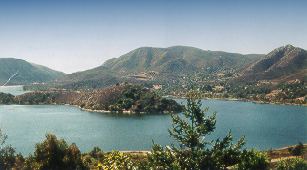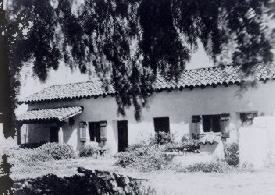 |

Several Indian tribes lived in the fertile parts of this region we call California. After their first contact with the "white man", many thousands died of diseases they had never known, leaving the land undefended. Rancho Santa Fe was once an Indian rancheria.
A Portuguese explorer, Juan Rodriques Cabrillo (employed by Spain) discovered
San Diego Bay in 1542. Spain considered California to be their property.
Another fellow by the name of Francis Drake, an English sea captain was
going around the world and decided to take a look at the coast of California
and claimed the land for England and even named it, New Albion. The Spaniards
learned of this and feared they might lose California to the English so
they sent several expeditions to see if it was worth saving. One of these
expeditions was lead by Sebastián Vizcaíno. He named many
landmarks along the coast, and sent an enthusiastic report about California
to the king of Spain urging that Spain colonize California.
His advice was finally taken and in 1769, the governor of Baja California
(lower), Gaspar de Portolá, led an expedition that established
the first presidio (military fort) in San Diego. The soldiers accompanying
the governor were known as "leather-jacket soldiers" and it
was one of these who was the father of Juan Maria Osuna. The son, also
became a soldier and for many years served at the San Diego Presidio.
In 1806, Osuna married Maria Juliana Josefa Lopez in a ceremony at the
San Diego Mission. Osuna played a major role in the establishment of the
pueblo of San Diego (population 150) and was elected alcalde (mayor).
In addition, Juan Osuna became a Justice of the Peace and was administrator
of the San Diego Mission.

As Mayor, one of Juan Maria Osuna's powers included the approval of petitions
for land and he quiet naturally approved his own application for the San
Dieguito grant (Rancho Santa Fe). In 1845, Governor Pio Pico awarded him
full title to the two square leagues of land (8,824.71 acres) that comprised
Rancho San Dieguito. Osuna built an adobe home on the ranch for himself
and his wife and gave an existing adobe to his son, Leandro. Osuna was
considered a fine alcalde but was also a gambling man and lost some of
his land to pay off bad debts. Leandro took possession of the ranch in
1851 when his father died. Although a veteran of the battle of San Pasqual
in 1846, Leandro was a man of unpredictable temperament and treated the
Indians cruelly. Rumor has it that the Indians tired of his harsh treatment
and poisoned Leandro. They told Leandro of his impending, painfully slow
death and it is said that he committed suicide rather than face such an
end. The care of Rancho San Diequito fell to Juliana, Juan Osuna's, widow.
By 1875, only a small portion of the land remained in the possession of
the Osuna family. The last parcel under their ownership, 116 acres, was
sold in 1910.
More Recent History
From 1906 to 1917, the Santa Fe Land Improvement Company, a subsidiary of Santa Fe Railway, purchased all the lands that made up the original San Dieguito Land Grant. The railway began planting groves of eucalyptus trees which they wanted to harvest for new railroad ties. The eucalyptus wood was too hard to hammer spikes into so it was decided that the Santa Fe Land Improvement Company should develop the property.

Before any development could take place, flooding in the the San Diequito
Valley had to be resolved. With the cooperation of Colonel Ed Fletcher,
a noted civic leader and developer, William G. Henshaw, who had acquired
extensive riparian rights and reservoir sites, and W.E. Hodges, then vice
president of the Santa Fe Railway, the agreements were made towards the
construction of Lake Hodges Dam. The Santa Fe railway financed the project,
Mr. Henshaw contributed the site and the dam opened the area for orchards
and residential development. The dam was completed in 1917 and soon thereafter,
the Santa Fe Land Improvement Company began a carefully planned subdivision
of its tract, using every source to preserve its beauty and historic traditions.

Ms. Rice believed that Paseo Delicias, the Civic Center, should be the
foundation of the development and a resource for subsequent building throughout
the community. Lilian Rice served as supervisory architect for Rancho
Santa Fe from 1922 -1928. She designed the school, La Morada (now the
Inn), the Civic Center and a number of private residences. Rice also served
a the architectural reviewer, a function of the present day Art Jury.
Also, among her many contributions towards preservation of the community's
heritage was rehabilitation of the two Osuna adobes. A.H. Barlow, a prominent
La Jolla businessman, purchased the historic Leandro Osuna Adobe in 1924,
saving it from certain destruction. Serveral years later, Lilian Rice
completed its rehabilitiation. It remains intact on a knoll overlooking
the San Dieguito River Valley.
The second of the two adobes is believed to have been built by Juan Maria
Osuna on the land grant deeded to him around 1845. Called Rancho San Dieguito,
the surrounding land and adobes passed through various owners in the the
ensuing years. In 1932, Bing Crosby purchased Adobe #2 with fifty acres
and hired Lilian Rice to design an additional house that would blend with
the old adobe.

Today, Rancho Santa Fe provides country living at its best with a championship
calibre golf course and tennis courts, as well as a Riding Club blessed
with miles of well maintained, dedicated trails. Children attend an outstanding
school and are provided with spacious playgrounds for sports. The beautiful
Library and Garden Club present many and varied programs. For the older
residents, the Senior Center offers transportation and various other services
when needed. The Association Art Jury and the Rancho Santa Fe Historical
Society are working to maintain the beauty and traditions of the Ranch,
and the many service clubs and social organizations provide for a well
rounded and enjoyable life style.
A Horse Lovers Paradise
Rancho Santa Fe is a true horse lover's paradise. With serious competitors in disciplines including hunter/ jumpers, dressage, western, breed and endurance, our area has a rich equestrian tradition. There are over 120 horse shows each year with in a 2 hour drive of Rancho Santa Fe. Major show grounds within 5 minutes of The Ranch include Showpark, Ride America, and the Del Mar Fairgrounds. Close by are such famous sites as The Oaks/ Blemin, The Los Angeles Equestrian Center, Orange County Fairgrounds, Huntington Beach Show Grounds, Galloway Downs and the 6 week HITS circuit in Indio. Based at the Rancho Riding Club in the heart of our community are world famous riders like Hap Hansen, one of the top Grand Prix money winners, and Olympic Dressage Medal winner Gunter Seidel. The Rancho Santa Fe Polo Club is based here, with polo matches drawing crowds from a wide area. Also, the Del Mar Thoroughbred Club holds its annual meet less than 5 minutes from Rancho Santa Fe, at the Del Mar Race Track, made famous by Bing Crosby. Trail and pleasure riders will also feel right at home in Rancho Santa Fe. Covenant homeowners can enjoy over 20 miles of private riding trails, groomed and maintained by the Association
![]()
|
San Diego by Night
|

